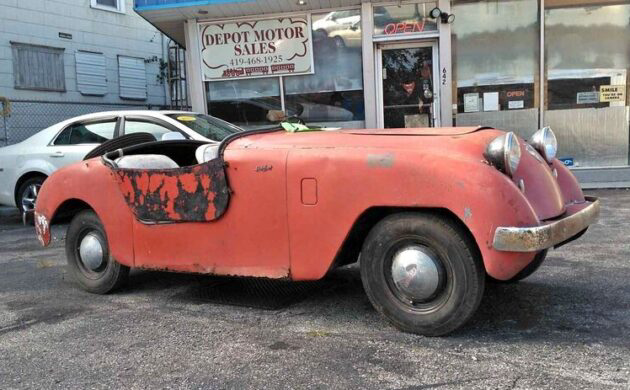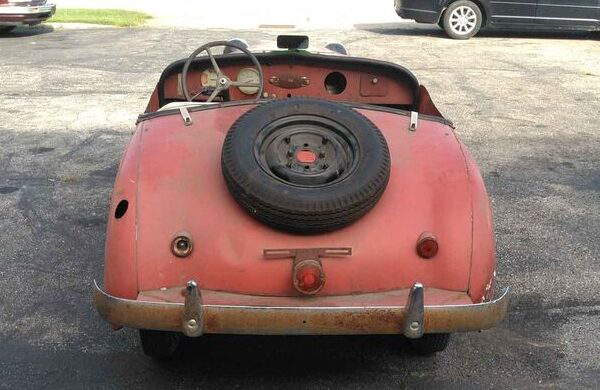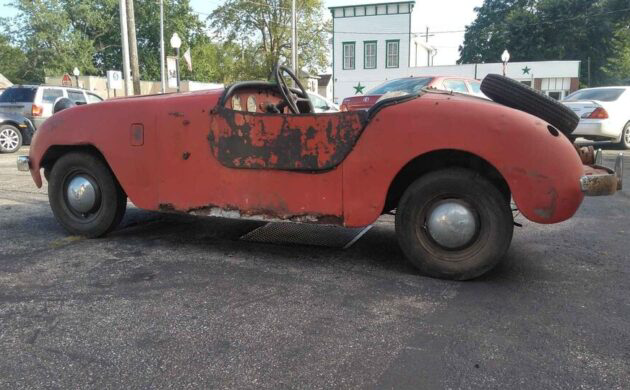Running Sports Car Project: 1949 Crosley Hotshot
Hollywood studios have spent decades endowing their animated automotive offerings with faces and winning personalities. From Disney’s Susie the Little Blue Coupe to Lightning McQueen from the “Cars” franchise, all featured faces brimming with character. Looking at this 1949 Crosley Hotshot head-on suggests that those individuals needed to look no further than this classic for inspiration. The placement of the headlamps, badge, and the opening above the bumper provides the impression of a car with a cheeky little grin. Of course, that could also be my imagination running wild due to sleep deprivation and too much coffee! This Crosley is largely complete, and the seller has coaxed its engine back to life. It desperately needs a new owner willing to return this gem to its former glory. Therefore, the Hotshot is listed here on Facebook in Galion, Ohio. You could take it home by handing the seller $4,250, and I must say a big thank you to Barn Finder Ted for spotting this pocket-size project.
Crosley was a minnow that dared to be different in a world of motoring giants. While most manufacturers concentrated on models that grew in length and width, most of Crosley’s models seemed destined to fit into the trunk of those giants. Okay, maybe that’s an exaggeration, but I think you get the idea that Crosley focused on small cars. It introduced the Hotshot in 1949, a vehicle often considered North America’s first post-war sports car. Our feature car is from the first production year, and it is largely complete. It is missing its windshield and fuel tank. An admittedly brief online search failed to locate new glass, but a shiny new tank would set the new owner back under $600. The Red paint is beyond help, and stripping this gem to bare metal would be the most sensible approach to recapture its youthful good looks. I can see a few minor bumps and bruises but no panel damage justifying steel replacement. There is matching rust in both lower rockers, but the rest of the car appears rock-solid. A trip to the platers is on the agenda for the bumpers, and the buyer will need to choose whether to restore or replace the hubcaps.
I’m disappointed the seller doesn’t supply engine photos, but the mechanical news is positive. The Crosley features a 749cc four-cylinder powerplant that sends 27hp and 33 ft/lbs of torque to the rear wheels via a three-speed manual transmission. Don’t be fooled by the modest engine specifications because the Hotshot could spring a surprise or two. The curb weight of 1,175 lbs is impressive, but removing items like the spare wheel, soft-top, side curtains, and windshield could drop that figure to 1,100 lbs. That was a common practice for circuit racing and club competition and allowed the car to improve significantly on its official ¼-mile ET of 23.5 seconds and a top speed of 67mph. The seller recently treated this classic to new points, a condenser, and a coil. They say the engine runs, representing a great starting point for an enthusiast focused on returning this Hotshot to a roadworthy state.
The need for TLC continues inside this Hotshot because the shopping list will include seat covers, carpet, a speaker grille, and the restoration or replacement of the badly cracked wheel. During a brief online search, I had no luck finding these parts, but I may have struck gold nonetheless. I chanced upon the Crosley Auto Club website. It includes an excellent list of vendors that could assist the new owner in locating anything required to return this Hot Shot to a factory-fresh state.
If you made a list of everything buyers weren’t seeking in an automobile in post-war America, the Crosley Hotshot contained most of those attributes. It was tiny in a market where bigger was becoming better. It featured a Lilliputian four-cylinder powerplant when buyers clamored for anything with a V8 under the hood. However, it was a two-seat sports car, offering a local alternative to traditional British drop-tops. This 1949 model is an affordable project ideal for an owner with limited workshop space. That begs the question of whether the cost of the build is justified. This is a project where the buyer could be hands-on across most of the process, and that approach could yield impressive financial gains. Recent sales results suggest that a high-end restoration would see a value above $15,000, while perfection would comfortably push the price beyond $20,000. If that isn’t enough to tempt you, it is worth noting that Hotshot values are climbing faster than the market average. That makes it worth a closer look.
Auctions Ending Soon
 1969 Ford MustangBid Now14 hours$1,050
1969 Ford MustangBid Now14 hours$1,050
 1965 Ford Falcon Station WagonBid Now3 days$2,300
1965 Ford Falcon Station WagonBid Now3 days$2,300
 2002 Jaguar XK8 ConvertibleBid Now4 days$4,250
2002 Jaguar XK8 ConvertibleBid Now4 days$4,250
 1979 Chevrolet Camaro Z/28Bid Now5 days$4,500
1979 Chevrolet Camaro Z/28Bid Now5 days$4,500
 1960 Dodge D300Bid Now5 days$300
1960 Dodge D300Bid Now5 days$300






Comments
This looks like it could be a fun project. There is no doubt in my mind it would be the only one at a local cars and coffee or car show. I actually had a Crossley wagon pull up next to me at a light around 5 am on my way to work, in really nice shape about a month ago. I cant even recall the last time i saw one on the road. I wouldnt take this on a highway, but would be fun to drive on some local back twisty mountain roads. I really hope someone restores this and enjoys it.
Agreed, and also with the look of an embryotic bug-eyed Sprite.
This Bugeye owner agrees with you on that.
Looks like it belonged to an amusement park ride long ago.
Does anyone else agree ?
That was my first thought also.
People, in 1949, were embarrassed to be seen driving one of these. But now? It’s worth someone saving.
The pre ’49 cars were rounded like the hot Shot and didn’t look that bad. The “square bodies” introduced in ’49 were pretty good looking but carrying over the rounded look to the Hot Shot wasn’t the brightest idea and the design was poorly thought out. Looked too much like a home built kit car. I changed the station wagon body on my ’49 to a ’48 which I liked the looks of and didn’t smell like it had been used as a chicken coop as the station wagon had been. The racers of the day doubled the horsepower on these little engines by winding them close to 10,000 rpm making the Hot Shot a formidable race car.
There were two types of engines.One sheet metal welded together and one with cast block.Wonder what this one has?
Crosley sports cars were all originally equipped with high-end CIBA cast-iron engines.
I’ve seen some pretty loose interpretations of lingo and such on this site but calling this a sports car tops ’em all.
Not so, read below,,
I’m sure that somebody out there slapped numbers on their Yugo, back in the day, too.
@RKKS You are wrong… The a number of drivers raced Hotshots successully in 1950, andd throughout the 50’s…. ou can find may results and wins in past racing history
Dave Perry OldSchool Restorations of North Alabama USA
iirc the first winner of a race at Sebring was a Hotshot, in 50 or 51 maybe, prior to the first of the 12 hours…
I hear you loud and clear! I saw one at a land speed event at the old Loring Air Force base in Maine. They are incredibly small and excruciatingly slow. This guys top speed was in the 60s, lol! The one I saw was about the same condition as this one, minus the rot through.
There were two types of engines.One sheet metal welded together and one with cast block.Wonder what this one has?
The cast block was introduced in ’49 so I’d guess one is in this car.
I read somewhere thay Crossley replaced some of the Copper brazed sheetmetal engines with iron block ones, even if they were still running. So even if it came from the factory with the COBRA engine, theres a chance it would have the CIBA engine in its place. Im sure theres more knowledgeable folks on here than me with Crossleys. Hopefully theyll chime in.
I had a really neat 51 Super Sports. My car actually raced at Watkins Glen back in the early 50s. The overhead cam 4 cylinder really made a great sound singing down the road. Bigger tires in the back pushed max sustainable speed up to mid 70’s and it could hit 80 if you pushed it.
You know( here it comes), what is tragically funny about this site, is the stark difference in its viewers. The site is clearly “us( old farts) Vs. them( younguns). Younger folks may think, “Hotshot”, what a stupid name,,but,,in THAT war, dubja, dubja 2, a “Hotshot” was indeed a glorified marksman. They were cocky, but earned the right to be so. Some say this isn’t a “sports car”, as before the war, we didn’t have much like this. GIs told of vast parking areas filled with little sports cars returning from Europe. This, was Americas first rendition of a sports car. 2 seat, 4 cylinder, open top, 1st with (poor) disc brakes, just the wrong timing. Britain had much success with the Sprite 10 years later, that wasn’t much different. After the war, most “Hotshots” went for more exciting cars, like the Olds Rocket 88, and I doubt many REAL hotshots ever considered a Crosley, but hey, marketing said it would be a hit.
In my best Cliffy Claven voice, der, it’s a little known fact, while Crosley was the leading producer of home radios and appliances( my folks had a Crosley fridge,,green, natch) and the Crosley car never had a Crosley radio. They used Motorola for some reason. Many jumped on the micro car bandwagon, dozens, but some, like King Midget and Crosley did better, but not much. Americans wanted big V8s, couch rear seats and such, not “puddle jumpers”, my old man called them. Probably destined to be a gasser, if anyone still does that.
People used to call the other Crosleys, not the Hot Shot, as ‘those little cars that look like radios.’
👏🏼👏🏼👏🏼I love your take on this posting of the Crosley Hot Shot! And I totally heard Cliff’s voice! 😂
Thanks, I was a bit worried on my “Hotshot” meaning from the war, as someone might challenge that, but that was the story my dad( yep, sometimes he was my dad) told, and he was there. Cheers was my favorite show
To Dave, I realize the 2 cars are totally different, but my point was, A-H brought out the Bugeye, essentially the same type of car, with great success.
BTW, the term “Hotshot” takes on an entirely different meaning today. It refers to smaller dually diesel trucks pulling 3 axle goose neck trailers, and specialize in smaller loads where a semi can’t go.
Howard, as an owner of both Crosley (1954-56) , then Sprite ( 1959 on)… there is NO similarity between the two. Not only in the cars themselves, but in the orriginal concept of design.. The Sprite was engineered to BE a performing Sports Car, and designed to be built from parts of other cars that were already existing. The Crosley design was stil preWar, except for the much late addittion of disc brakes…. The ’48 I owned in the midd 50’s still had mechanical drum brakes and had a hand operated windshield wiper.
It must’ve been fun driving in the rain while try to operate the windshield wiper and steer.
Do like Carrol Shelby…Shoehorn a small V-8 in it and upgrade brakes & steering and i bet you WILL have a Hotshot…
Knew a woman at college whose father loved the Crosleys so much he named his son that.
To Jesse and Adam Clarke, thanks for posting my “find”! What a fantastic write up! I was entertained throughout the whole description!
I went to read up on the original posting of this car on FB Marketplace and I discovered another 1949 Hot Shot selling in Lawerenceberg, IN!
I have enjoyed reading all the of the barn finds here! Thank you! Ted
Thank you so much for your feedback and kind words, Ted. It was a pleasure to feature this car, and it is one of the reasons that I love writing these articles. I hope you continue to enjoy our work, and please keep sending those leads through.
Make that Lawrenceburg, IN! Sorry!
I never owned one of these Hotshots, although I did own a twin Crosley-engined rail dragster built by Crosley guru Nick Brajevich (BRAJE Speed Equipment). It was professionally built and even had a signature Tony Nancy interior. It looked like a miniature version of the famous Don Prudhomme rail “Greer-Black-Prudhomme”.
I also owned a stretched Crosley 6 wheel fire truck used for parades and kiddy rides around “Follows Camp” in SoCal. It is new at the LeMay museum.
Would love to see a picture of the stretched fire truck.
If you look up Japanese midget trucks they have some resemblance to the Hotshot…although they are single seat vehicles designed for deliveries etc.
If I was going to do an engine swap in a Crosley, I think I’d rather do a motorbike engine, like a Hayabusa with a six speed car transmission (and add hydraulic brakes!)
Funny, I just came across a 1947 Crosley convertible in town yesterday. The owner is 88 years old and he had hot-rodded it with a 305 V8. Bucket seats and I think it had a backseat. The convertible is the type that rests on the door frames that have a wood cap. The frame was extended beyond the nose with the axle and a fake moon eyes fuel canister set in the middle. Kind of a flat red rust primer. Big fat tires in the rear and little skinny ones up front. The bucket seats were high enough he didn’t have to struggle too much to enter and exit. Very rough ride, he said.
In the late 1950’s one of our neighbors was a milkman who owned a Crosley station wagon. He used the Crosley to once pull our new toboggan on the street after a snowstorm in the Chicago suburb we lived in. As a matter of fact, that was the first and only time that toboggan was ever used. The rest of the family never understood why my father bought the thing since we were not active outdoors type of people. But it has made for a lasting memory from childhood.
It looks like the Marcia Brady (middle child) in a family where the youngest is a Berkeley and the oldest is a Bugeye Sprite. Cool car!